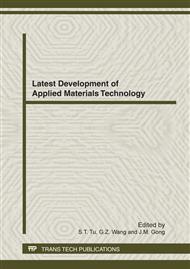[1]
M.Perez and A. Deschamps, Microscopic modeling of simultaneous two-phase precipitation: application to carbide precipitation in low-carbon steels, Mater Sci Eng. A360 (2003)214-219.
DOI: 10.1016/s0921-5093(03)00431-3
Google Scholar
[2]
J.T. Buswell, P.J.E Bischler, S.T Fenton, A.E Ward and W.J Phythian, Microstructural developments in neutron-irradiated mild steel submerged-arc weld metal, J Nucl Mater. 205(1993)198-205.
DOI: 10.1016/0022-3115(93)90082-a
Google Scholar
[3]
P. J. Othens, M. L. Jenkins and G. D.W. Smith, High resolution electron microscopy studies of the structure of Cu precipitate in a-Fe, Phil. Mag. A70(1994)1-15.
Google Scholar
[4]
T.A. Abinandanan, F.Haider and G.Martin, Computer simulations of diffusional phase transformations: monte carlo algorithm and application to precipitation of ordered phases, Acta Mater. 46(1998)4243-4255.
DOI: 10.1016/s1359-6454(98)00107-4
Google Scholar
[5]
H.P. Ren, H.Y. Wang, Z.C. Liu and Z.G.An, Nanometer Stripe Microstructure of Supersaturated Sol id Solution in Fe-Cu Alloy, J iron & steel research inter.14(2007)64-68.
DOI: 10.1016/s1006-706x(07)60014-4
Google Scholar
[6]
S.I Golubov, A. Serra, Y.N. Osetsky and A.V Barashev, On the validity of the cluster model to describe the evolution of Cu precipitates in Fe-Cu alloys, J Nucl Mater. 277(2000)113-115.
DOI: 10.1016/s0022-3115(99)00238-x
Google Scholar
[7]
K.Osamura, H.Okuda and S.Ochiai, precipitate hardening in Fe-Cu binary and quaternary alloys, ISIJ Inter.34(1994)359-361.
DOI: 10.2355/isijinternational.34.359
Google Scholar
[8]
F. Perrard, A. Deschamps and P. Maugis, Modelling the precipitation of NbC on dislocations in a-Fe, Acta Mater.55(2007)1255-1266.
DOI: 10.1016/j.actamat.2006.10.003
Google Scholar
[9]
A.V. Barashev , S.I. Golubov , D.J. Bacon, P.E.J. Flewitt and T.A. Lewis, Cu precipitation in Fe-Cu alloys under electron and neutron irradiation, Acta Mater.52(2004)877-886.
DOI: 10.1016/j.actamat.2003.10.023
Google Scholar
[10]
O. Khrushcheva, E.E. Zhurkin, L.Malerba, C.S. Becquart and M.Hou, Copper precipitation in iron: a comparison between metropolis Monte Carlo and lattice kinetic Monte Carlo method, Nucl Instruments and Methods in Phys Research B.202(2003)68-75.
DOI: 10.1016/s0168-583x(02)01830-x
Google Scholar
[11]
S. Schmauder and P. Binkele, Atomistic computer simulation of the formation of Cu-precipitates in steels, Computational Mater Sci.24 (2002)42-53.
DOI: 10.1016/s0927-0256(02)00163-5
Google Scholar
[12]
R. Wagner and R. Kampmann, Characterization of microstructures with sizes from the sub-nm to the μm-range by extended small-angle neutron scattering, Physical B Condensed Mater. 241-243(1997)98-100.
DOI: 10.1016/s0921-4526(97)00521-8
Google Scholar
[13]
W.M. Mao, H.P. Ren and Y.N.Yu, Ageing strengthening effect of precipitates containing copper in structural steels, Trans Mater Heat Treat.25 (2004)1-4.
Google Scholar


